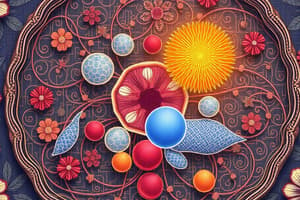Podcast
Questions and Answers
What organelle is responsible for converting energy from sunlight into chemical energy in plant cells?
What organelle is responsible for converting energy from sunlight into chemical energy in plant cells?
- Nucleus
- Mitochondrion
- Chloroplast (correct)
- Golgi apparatus
Which organelle is involved in protein synthesis in both animal and plant cells?
Which organelle is involved in protein synthesis in both animal and plant cells?
- Ribosomes (correct)
- Mitochondrion
- Nucleus
- Golgi apparatus
What structure in animal cells is responsible for initiating microtubules during cell division?
What structure in animal cells is responsible for initiating microtubules during cell division?
- Centrioles (correct)
- Mitochondrion
- Lysosomes
- Golgi apparatus
Which organelle in eukaryotic cells is involved in the breakdown of waste products?
Which organelle in eukaryotic cells is involved in the breakdown of waste products?
Where are proteins modified, sorted, and packaged for transport to other parts of the cell or for secretion?
Where are proteins modified, sorted, and packaged for transport to other parts of the cell or for secretion?
In eukaryotic cells, where is DNA typically found?
In eukaryotic cells, where is DNA typically found?
Which organelle is responsible for generating energy in the form of ATP through cellular respiration?
Which organelle is responsible for generating energy in the form of ATP through cellular respiration?
What is the function of the rough endoplasmic reticulum (RER) in a cell?
What is the function of the rough endoplasmic reticulum (RER) in a cell?
Flashcards are hidden until you start studying
Study Notes
Cellular Transport
- Substances are transported around the cell in the spaces between organelles.
- Smooth ER (SER) helps make and transport lipids.
- Rough ER (RER) is dotted with ribosomes and makes and modifies proteins.
Endomembrane System
- Golgi apparatus is a flattened stack of sacs that modify, store, and repackage substances from the ER, mostly for secretion.
- Vesicles are small sacs containing substances like enzymes, proteins, and lipids that store or transport substances around the cell or outside the cell.
Lysosomes
- Lysosomes are special vesicles that contain digestive enzymes to break down and recycle nutrients and cell parts, and destroy bacteria.
Insulin Production
- Insulin production involves DNA in the nucleus, RNA exiting through nuclear membrane pores, insulin assembly in RER, modification in the Golgi apparatus, and secretion outside the cell.
Cell Classification
- Protozoa, fungi, plants, and animals are eukaryotic cells, which have a nucleus containing DNA.
Nucleus
- The nucleus is a compartment in the cytoplasm surrounded by a double membrane, containing chromatin (DNA and protein), nucleolus (where rRNA is made), and nuclear envelope with nuclear pores.
Ribosomes
- Ribosomes are the "factories" of the cell, making proteins, and can be free in cytoplasm or attached to ER (RER).
- Ribosomes are made of protein and rRNA and have large and small subunits.
Mitochondria
- Mitochondria make ATP by converting energy from sugars (e.g., glucose) into ATP, which is used by the cell.
Cellular Organelles
- Animal cells have centrioles, flagella, and lysosomes.
- Plant cells have chloroplasts, large vacuoles, and cell walls made of cellulose.
- Both have cytoskeleton (microtubules, centrioles, and fibers) for support and organelle movement.
Studying That Suits You
Use AI to generate personalized quizzes and flashcards to suit your learning preferences.




